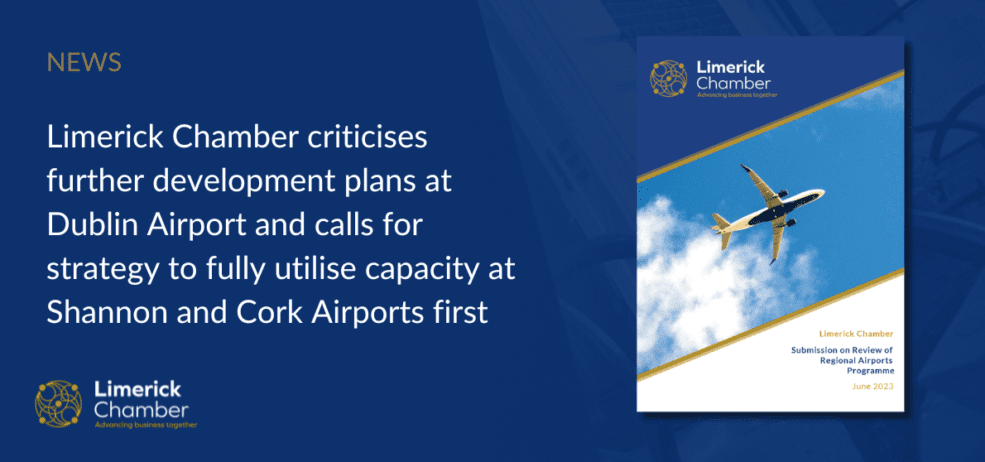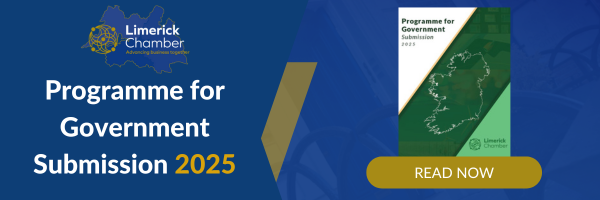Limerick Chamber has called on Government to include state-owned regional airports in Regional Airports Programme (RAP) to increase investment and support the introduction of business routes to Northern Europe.
Limerick Chamber, the largest business representative group in the Mid-West, has once more queried stated plans for further development at Dublin airport, compounding challenges of congestion and unaffordable house prices in the Dublin city area, and has asked why the State does not first develop a strategy for better utilisation of capacity at Cork and Shannon airports.
The representative body has rejected the assertion that an extension to terminal 1 is ‘necessary’ highlighting in it’s recent submission to the Department of Transport the spare capacity at other motor-way connected airports to handle higher traffic volumes.
Dee Ryan, CEO said
It beggars’ belief that in 2023, when faced with stark regional disparities and housing pressures, the Government has not taken National Aviation Policy by the scruff of the neck and reworked it to support delivery of jobs and housing in Cork, Kerry, Limerick, Tipperary, Clare and Galway.
There are obvious consequences to the over development and oversized market dominance of the capital city airport, it is time for the Government to take the matter in hand and deal with it. Yes route connectivity is essential to the national economy and to sustain the businesses that we have. No, it does not all need to come through one airport.
Responding to the Department of Transports ‘Mid-Term review of the Regional Airport Programme 2021-2025’ the business group called on Government to include all airports with less than 3 million passengers annually to be eligible to compete for funding in the Programme and not exclude Cork and Shannon airport as was practice up until 2020.
In their Submission to the Department of Transport, Limerick Chamber highlighted the need to include state-owned regional airports in the programme and urged caution in including private airports only as it creates an uneven playing field between the regional airports.
The submission emphasises the need to support key economic routes to a Northern European Union hub with onward connectivity, highlighting that post-Brexit, Shannon Airport no longer has a direct daily connectivity to an EU hub.
Having surveyed its members Limerick Chamber found a lack of EU hub service and poor public transport links are the two main inhibiting factors to businesses in the Mid-West using their local airport.
Calling for an all-agency approach for public transport to airports, the business group said regional rail and bus connectivity would be key to ensuring that state-owned airports are maximised and routes maintained without expanding Dublin Airport further.
Seán Golden, Chief Economist and Director of Policy with Limerick Chamber, said:
Limerick Chamber has long been an advocate for using aviation policy as a tool for encouraging more balanced regional development. In 2019 we contracted Copenhagen Economics to undertake an aviation study of the Mid-West and West. Many of their recommendations and observations remain valid to this day, there is an over reliance on Dublin, there is large, underutilised capacity in regional airports, the need for an updated National Aviation Policy and of course, that state-owned regional airports, such as Shannon and Cork, should be included in the plan long-term
Regional Airports have huge potential to help Ireland reach the balanced regional development goals underpinning Project Ireland 2040, but that means including regional airports in the programme and encouraging a more level playing field between all-Irish airports.
There is large unrealised capacity at regional airports but yet there is talk of terminal 1 expansion and even a third runway at Dublin Airport. Notwithstanding regional development goals, there are huge, embodied carbon concerns by not utilising existing assets to their full capacity and building new infrastructure at an airport that already accounts for the vast majority of passengers.
Looking at European neighbours can show how Ireland’s aviation policy is far too reliant on Dublin; in Ireland 85% of passengers travel through Dublin, meanwhile, in Norway just 50% of passengers pass through their capital airport, in Portugal and Switzerland it is 51%.
There is a significant demand from the business community for a direct route to a Northern European aviation hub that offers seamless onward journey potential. Public Service Obligation (PSO) routes are used very effectively in a European context to increase linkages between countries, but it isn’t something we have done in Ireland in the past and now is time for that to change. As an Island economy on the edge of Europe it is vital that we use aviation policy as a tool to form closer ties to Europe, especially from a business perspective when many multi-national corporations base their EMEA headquarters in Ireland.
Limerick has the largest catchment area within a 90-minute journey outside Dublin. There is a population of c. 1.3 million people, and this catchment overlaps with Dublin around the Portlaoise area but due to route availability many people in the regions will still find themselves travelling longer journeys to Dublin for flights.
A PSO route to an EU hub is considered by many in the West and Mid-West as vital for the economic and social development of the region. Funding this route can forge strong links between economic and administrative centres in Ireland and Europe. It can lift connectivity hurdles for economic development of the regions. Unfortunately, as an island nation, there is no other transport alternative. Unlike European neighbours we can’t expand the rail network to other countries.
The inclusion of state-owned airports in the programme is a must and so too is the support of business routes if we want to continue to attract and retain investment.
Follow Limerick Chamber on social media for more insights
![]() LimerickChamber
LimerickChamber
![]() Limerick Chamber
Limerick Chamber
![]() Limerick_Chamber
Limerick_Chamber
![]() Limerick.Chamber
Limerick.Chamber




